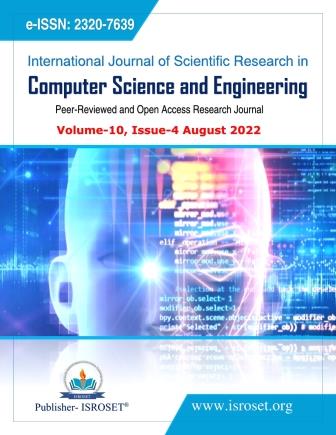Design and Development of an Interactive Chatbot Application for General Health Evaluation and Diagnosis
Keywords:
COVID-19, mental health, respiratory ailments, expert system, certainty factor, diagnostic system, MedBot, Chatbot, AI, NLTK, APIAbstract
Technology goes about as a scaffold between people and medicine. It helps make people`s lives much more straightforward. Coronavirus made a lot of ruin in the existence of many leaving them in a fatigued state all over the world. Indeed, even a little disarray in the well-being of an individual set off various considerations about his well-being as a top priority. As per research, several million calls were made by people to the helplines in many nations during the first wave of COVID-19 concerning mental distress and physical health. In an uncertain situation, insight incorporated into a chatbot with medical knowledge would help individuals to self-evaluate. Based on this, users can choose to check with a specialist for additional conclusions. A devoted intuitive and interactive Chatbot with a knowledge base of eminent illnesses on the planet makes it simpler. Our approach for MedBot is to make an interactive self-check chatbot to give the medical diagnosis in health categories such as Mental, Respiratory, Cardio, Neuro, and Ortho considering the underlying conditions of the disease. It covers most undiscovered yet normal diseases in the referenced health categories. It targets assisting individuals with the technology to check their psychological and general wellbeing. MedBot allows the patient to interact with the chatbot to enter the symptoms he is experiencing. It then furnishes the disease finding alongside the certainty of the disease. The value of the Certainty factor gives more exactness to the conclusion of the diagnosis.
References
A. Khadija, F.F. Zahra, A. Naceur, “AI-Powered Health Chatbots: Toward a general architecture”, Volume 191, Pages 355-360, 2021.
A. Shangrapawar, A. Ravekar, S. Kale, N. Kumari, A. Shende, P. Taklikar, “Artificial Intelligence based Healthcare Chatbot System”, Vol.7, Issue.2, Feb 2020.
Bushra Kidwai, Nadesh RK, “Design and Development of Diagnostic Chabot for supporting Primary Health Care Systems”, Vol.167, 75-84, 2020.
Frazier RN CMA BS, M. Schell, Drzymkowski RN BS, Jeanette, "Essentials of Human Diseases and conditions", Published by Saunders, 2008.
George Newman, “How to Assess Mental Status”, May 2020.
H. Mendapara, S. Digole, M. Thakur, A. Dange, “AI-Based Healthcare Chatbot System by Using Natural Language Processing”, Vol.4, Issue.2, Mar-Apr 2021.
John Durkin, “Expert systems: Design and development”, Published by Macmillan, 1994.
M.M. Mastoli, U.R. Pol, Rahul D. Patil, "Reasoning with Certainty Factor for Prediction of Diabetes Disease on Machine Learning Platform," International Journal of Scientific Research in Computer Science and Engineering, Vol.8, Issue.1, pp.93-97, 2020
Tjiptomongsoguno, A.R.W., Chen, A., Sanyoto, H.M., Irwansyah, E., Kanigoro, B, “Medical Chatbot Techniques: A Review”, Vol.1294, pp 346-356, 2020.
Wael Ben Amara, Amani Touihri, Salma Hamza, "Speech Recognition for COVID-19 Keywords Using Machine Learning," International Journal of Scientific Research in Computer Science and Engineering, Vol.8, Issue.4, pp.51-57, 2020
William van Melle, "MYCIN: a knowledge-based consultation program for infectious disease diagnosis", Vol.10, Issue 3, Pages 313-322, 1978.
Z. Safi, A. Abd-Alrazaq, M. Khalifa, M. Househ, "Technical Aspects of Developing Chatbots for Medical Applications: Scoping Review", Vol.22, No.12,2020.
Downloads
Published
How to Cite
Issue
Section
License

This work is licensed under a Creative Commons Attribution 4.0 International License.
Authors contributing to this journal agree to publish their articles under the Creative Commons Attribution 4.0 International License, allowing third parties to share their work (copy, distribute, transmit) and to adapt it, under the condition that the authors are given credit and that in the event of reuse or distribution, the terms of this license are made clear.







